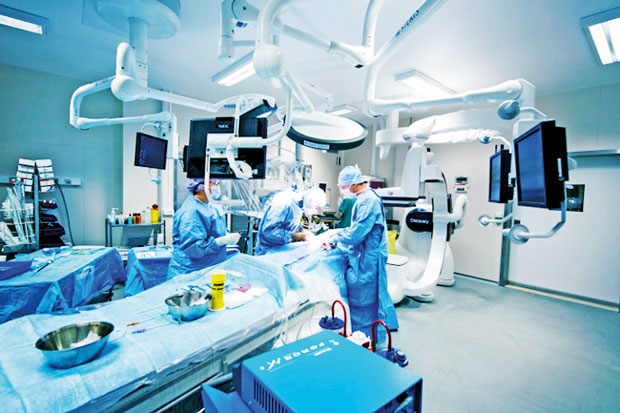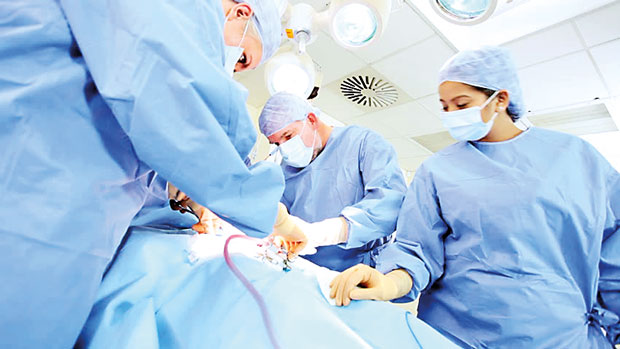06 Oct 2017 - {{hitsCtrl.values.hits}}

 Have you ever had to be under the mercy of a surgeon’s knife? The knowledge that your skin is split apart, the muscle layers separated, ultimately making way into a body cavity is a bit intimidating, even when it’s a ‘minor’ surgery. I was intrigued by the concept when I was around 10 years, when my sister fractured her arm which had to be operated on. Green dresses, covered faces, hushed voices, big lights barely glimpsed through closing doors, all intimidated me as well as aroused my need to discover the secrets inside the almost sacred chamber. It took more than 10 years to realize my goal, though I’m far from discovering even half of the secrets hidden inside the chamber. Since some of the readers of the ‘Health Capsule’ might be planning to undergo surgeries in the future, or are maybe having the same curiosity as me, I decided to give a brief introduction about the vast topic called ‘surgery’ in today’s interesting medicine.
Have you ever had to be under the mercy of a surgeon’s knife? The knowledge that your skin is split apart, the muscle layers separated, ultimately making way into a body cavity is a bit intimidating, even when it’s a ‘minor’ surgery. I was intrigued by the concept when I was around 10 years, when my sister fractured her arm which had to be operated on. Green dresses, covered faces, hushed voices, big lights barely glimpsed through closing doors, all intimidated me as well as aroused my need to discover the secrets inside the almost sacred chamber. It took more than 10 years to realize my goal, though I’m far from discovering even half of the secrets hidden inside the chamber. Since some of the readers of the ‘Health Capsule’ might be planning to undergo surgeries in the future, or are maybe having the same curiosity as me, I decided to give a brief introduction about the vast topic called ‘surgery’ in today’s interesting medicine.
Evolvement of Western surgery itself is quite interesting. While physicians treated medical maladies, if a person needed a surgical procedure such as an amputation: which was common than we imagine, they had to go to a barber, or even a butcher, since they were the people having the ‘skills.’ To top this off, they were not given any anesthesia, but some documents actually suggest that in big ‘surgeries’ the patient was ‘anaesthetised’ by knocking him off with a blow to his head. This gradually changed with the introduction of anesthesia to surgery in 1840s and has grown fast to reach what it is.
My first impression of a theatre as a ‘sacred place’ is not far off. There is a special set of rules called ‘theatre etiquette’ that every medical persona entering the theatre has to follow. Usually, in an average surgery, there are the nursing team, surgical team, anaesthetic team and the attendants. All these groups have special tasks assigned to them as well as special uniforms including shoes. When the patient is brought in, he or she is transferred to the operating table. Then the anaesthetician reassures the patient administers the sedatives. Everything is done under highly-sterile conditions. The participants scrub their hands with antiseptic, put on sterile gowns and gloves on top of the scrubs; they are prohibited from touching any other area other than the patient and the sterile equipment until the end of surgery. There is a special nurse practitioner in charge of the entire equipment tray.
She keeps watch over the tray and the equipment like a hawk, warning away anyone who comes more than a few feet near the trolley. She also keeps count of each wad of gauze that is used and discarded, so the chance of one being left inside the body, like which happens in movies, is extremely rare.

While the surgeon is bent over the patient, meticulously guiding the scalpel to reach his destination while avoiding all the nearby nerves and arteries, the anaesthetician is tasked with the equally, if not more, important job of keeping the patient stable. He does this with the help of all the monitoring equipment attached to the patient. Even the slightest change in blood pressure or oxygen level is attended quickly, to be brought back to normal levels.
Talking about surgery, it would be extremely-careless of me not to mention laparoscopic surgeries, which is to be the future of all surgeries, from knee joint to bypass surgeries. I remember my first time witnessing a laparoscopic surgery.
There was a huge TV situated in front of the surgeon and instead of the usual precise and long incision put by the surgeon’s sure hands, four tiny holes were made and instruments were inserted. We watched awestruck as the surgeon masterfully maneuvered the tools inside the cramped space with the guidance from the tube like camera inserted at one place, and the diseased gallbladder was skillfully taken out.
As the field of surgery is expanding more and more, the size of the incisions made and the complications of the surgery are becoming smaller and smaller, while surgeons are reaching the nooks and corners of the body which until now were deemed impossible to reach.
I hope this article gave the people awaiting surgery, prospective young surgeons and the ones thirsty for knowledge, an idea about Surgery, and the dedication of the professionals involved. Though if you want to gain further knowledge on the subject by watching videos, I will take the precaution of warning off the faint-hearted; excuse my pun: since the images may be ‘bloody.’
23 Dec 2024 2 hours ago
23 Dec 2024 4 hours ago
23 Dec 2024 4 hours ago
23 Dec 2024 4 hours ago
23 Dec 2024 6 hours ago